-
Posts
1,155 -
Joined
-
Last visited
-
Days Won
1
Content Type
Profiles
Forums
Blogs
Gallery
Events
Store
Posts posted by RobW
-
-
When I have time I will re-scan one of my official Rom vics in larger detail so that others can compare.
Here is another close-up of the official Rom vic.
Obverse.
Regards,
Rob
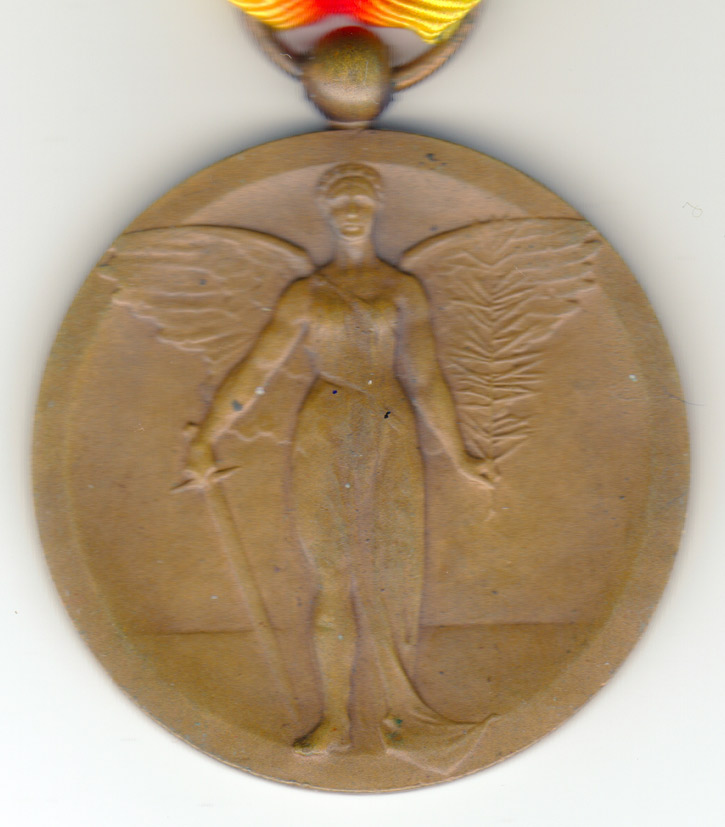 0
0 -
So, to the best of your knowledge, are there copies out there with the "Kristesko" stamp?
Much appreciated,
Tim
Hello Tim,
In regards a copy with the 'Kristesko' stamp; yes there is definitely such a type.
I will be a bit vague lest I contribute to the education of the fakers that may be out there. Specifically; the 'Kristesko' mark is in raised relief instead of the letters being incused as on the official vic.
It is most often seen on some of the online auction sites and is euphemistically sold as an official piece or even as a 'modern repro'.
Hope this helps.
Regards,
Rob
0 -
Let's backtrack for a moment to the Rumanian VIC.
Understanding the Laslo reference is now somewhat dated, with more information coming to light since his last revision in 1992 and more items being seen these days on the market; what do you think of this piece?
It was listed as an original with the designer's name "Kristesko" on the reverse. However, there are noticeable die differences between the official Type 1 that Laslo describes in his book and this one. Is this another modern example with the name added, or is it an authentic version Laslo did not cover?
Tim
Hello Tim,
This Romanian vic looks okay to me. Other than the fact that it is suspended from Italian victory medal ribbon, it just appears to be more worn in some areas than the examples I posted. I would suggest that the differences are as a result of some rubbing and wear on the face and obverse.
The 'Kristesko' signature on the reverse looks good to me as well, just slightly more worn. The rings and font used on the country names is consistent with an official issue.
In addition to those areas of wear that you have listed there is also a large amount of wear on the reverse of the ball suspender, indicating much rubbing and contact over a period of time.
When I have time I will re-scan one of my official Rom vics in larger detail so that others can compare.
Hope this helps.
Regards,
Rob
0 -
Question is Alex Laslo still alive and if so, does he have a web site.
Hello JM and others,
As mentioned by Kevin from Deva, Alex Laslo passed away on 1 March 2004 after a short illness. Additional details are provided in the May-June 2004 Journal of the Orders and Medals Society of America (Volume 55, Number 3).
This forum thread is as good a place as any to continue the promulgation of new information about the vic series as it comes to light.
Regards,
Rob
0 -
To those US vic collectors who participate on this thread,
Here are some pics of some engagement (battle) clasps to the US vic. Some collectors have suggested that these were produced in France but the collectors who I have corresponded with in France do not agree.
There are no markings on the reverse backstrap or reverse of the bar itself, as is usually the case with items produced in France, and there are file striations on the top and bottom edges of the bar showing signs of manufacture. The stars and font used are not consistent with French manufactured items.
Do any US collectors have any idea as to the background to these bars?
Regards,
Rob
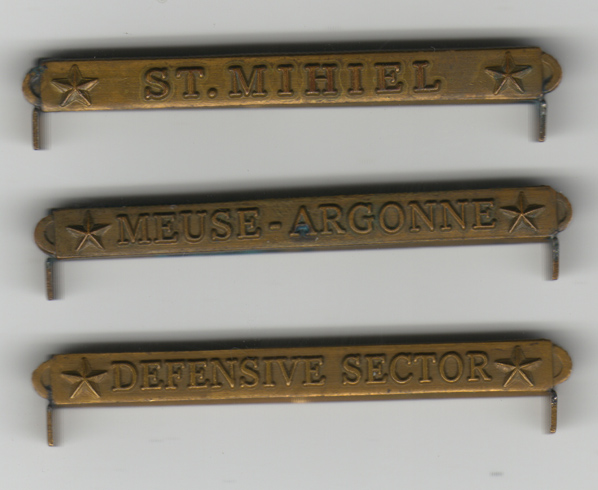 0
0 -
Can't explain the double post above, maybe it's me but never mind.
Here's a Czech VM I have. The ribbon appears to be nice and old, does anyone think it could be a Czech issue or should it belong to another country's VM?
Tony
Tony,
You have a nice Czech official strike with yet another variation of the unblended ribbon that is seen with Czech vics. Yours has the more commonly seen barrel suspender. Those earlier strikes, produced by Alexander Leisek, had a cylindrical suspender.
Regards,
Rob
0 -
Thanks Rob,
I think his employer enquired as to the whereabouts in May 1921 so probably just a grubby medal.
Below is the reverse of his MIC, looks like 2.5.21 to me. What do you think?
Tony
Hello Tony,
Yes I would agree that May 1921 looks correct.
The fact that there is so much detail on the MICs make them such a good source of information and it certainly assists the collector in conducting research. The story 'behind the medal' is in a lot of cases much more interesting than the actual medal itself.
Regards,
Rob
0 -
Hope it's ok to add this altered British Victory medal.
It was turned into a brooch and unfortunately the safety chain is missing. It has a brown colour instead of the usual gold. I can't be sure if it's the type 1 chocolate brown coloured VM mentioned earlier in this thread or if it's just dirty. The detail isn't too bad so maybe it's grime.
The recipient of this medal was often awol, paying fines, confined to barracks or doing much field punishment No. 2.
Tony
Hello Tony,
Welcome to the thread. Always good to see another face with vics.
If you check the recipient details against their MIC it should have an issue date for the medal. If it is before January 1921 it is most likely a type 1. If after that date it is, as you suggest, most likely just dirty or tarnished with time.
Regards,
Rob
0 -
Anyone have knowledge of the number 3 on a WW1 US Victory medal?
Hello Bosungus,
I have seen bronze and silver numerals affixed to both Navy and Marine Corps Expeditionary medals but not the vic. In the other cases these numerals were used to identify the number of expeditions the individual served on. I would suggest that the number on the vic ribbon probably represents the number of engagement bars that were awarded and present on the medal.
The only approved method of indicating such engagement bars were the small bronze stars that were affixed to the ribbon.
Hope this helps.
Regards,
Rob
0 -
And a view of Victory medal number 13 - lucky number I hope, somewhere...
It has a very nice ,I am told, original Czech ribbon.
regards
Thomas
Hello Thomas,
Yes it is a nice Czech re-issue type 2. The ribbon is, as you have suggested, an original one that was used with the re-issue Czech pieces that were produced immediately following World War 2. Comparison pics are on the thread at posts #27, #214, and #215.
It is always nice to obtain a piece with the 'correct to period' ribbon as it adds to the authenticity of the piece and can be referred to later.
Hope this helps.
Regards,
Rob
0 -
Very nice Rob. I hope the others post their fringe Victory Medals too.
A quick question to the knowledgable - I have a Victory Medal that was, according to the recipient's MIC, only issued in 1948. It is at least 1mm thinner ... the naming only just fits ...
... so what version does Laslo label this one as?
Hello Thomas,
I am not sure what Mr Laslo would have classed this piece as, but I would still call it an official issue, depsite the late date on the MIC.
This does bring up the point of what label do we put on specific items. I think that the individual classification of any of the vics is in the eye of the collector.
By way of illustration; In the 1920s and 1930s a number of French medal manufacturers (M.Delande, Arthus Bertrand, Chobillon, and Janvier-Berchot among others...) produced copies of some of the Interallied vic series. Some collectors would call them copies as that is technically what they are. I would call them reproductions as they were sold as such and sometimes used to replace lost / misplaced official issues. To muddy those waters they were also purchased by recipients for wear so it is all a subjective point.
Mr Laslo did produce a number classifications which are listed in his book so again it is an exercise in definitions.
Regards,
Rob
0 -
And here is a bronze example.
Regards,
Rob
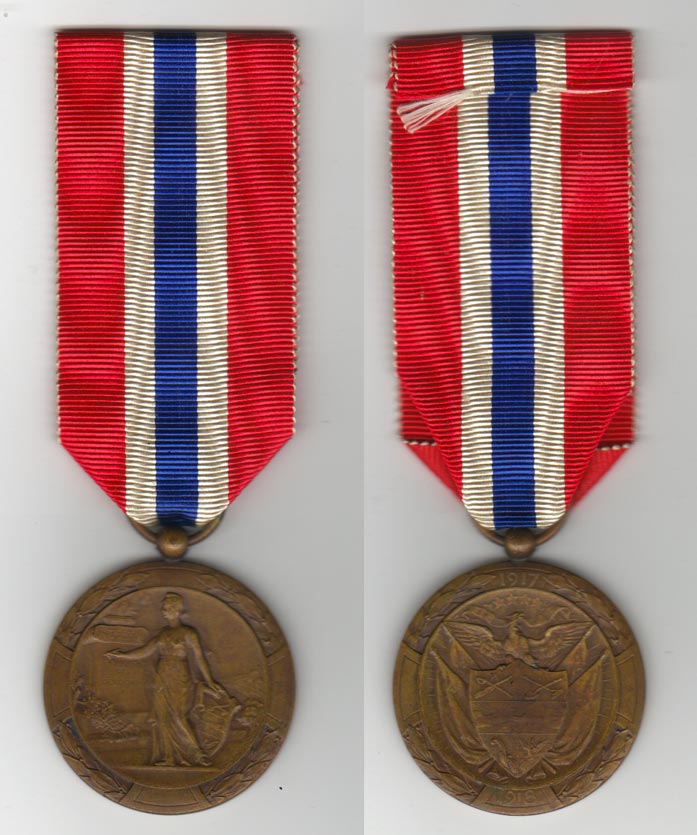 0
0 -
As we start out as a catch-all for items like Commemoratives, Anniversary, Fantasy items or whatever else.
Tim

Hello all,
Here are a couple of Panama Medals of Solidarity. While Panama played no active part in the Great War they did award this medal in solidarity to the allies and it is associated with the Great War and the Interallied vic series in general.
According to Alex Purves' book 'The Medals, Decorations & Orders of the Great War 1914-1918' this medal was produced in limited quantities, in three classes. Numbers awarded were reportedly 100 to each of the allied countries. Medals were awarded in gold (silver-gilt) to commanders in chief, silver with a rosette to generals and senior officers and bronze to officers and other ranks.
This silver version, while not mine, shows the rosette clearly.
Bronze example to follow.
Regards,
Rob
 0
0 -
Hello All -
... and just before this thread explodes with new posts, a "simple" trio that I picked up to a father and two sons.
Regards
Thomas
Hello Thomas,
That is certainly a very nice trio of family vics and having them all named makes such research all the more enjoyable. It is the story behind the medals that is of such interest.
I really can't see this thread exploding with new posts given the abject lack of regular posts but the thought is a good one. There are, alas, only a few consistent posters. More fun for us though.

Regards,
Rob
0 -
Off subject just for a moment.
To All
I need some help on identifying: 1) The other collar insignia next to the collar disk with crossed cannons. 2) Also the eagle to the right of the Victory medal. 3) Last the medal to the left of the Victory medal and the 2 ribbons above.
I just purchased this photo and it is signed by a Sgt. Alex Arch, 6th Field Artillery, 1St Division. He was credited pulling the lanyard on a French 75mm and firing the first U.S. Artillery piece in WWI for the AEF.
Thanks JM
Hello JM,
While I have not a lot of experience in US medals I think the medal to the left of the US vic could be: The Mexican Service Medal - Army, and I say that purely because of the ribbon stripes in the close-up. What may aid in researching this gentleman is the fact that he is wearing a silver citation star on his vic.
In regards the ribbon bar pair above the vic I think the ribbon to the left is the 'International ribbon' that was worn by a lot of recipients immediately following the Great War. It is commonly seen with the 'Veterans of Foreign Wars' ribbon. Here is a pic for reference.
Regards,
Rob 0
0 -
To all,
While this example has been posted previously in the Great Britain section, it is relevant given the context of this thread. Here is a bronze British war medal awarded to a member of the Chinese Labour Corps. Entitlement to the medal is confirmed.
As alluded to in the previous post it is the only 'official' recognition that the Chinese workers received. It is, to my mind, more indicative of the Chinese service in the Great War and certainly complements a vic collection.
Given its scarcity, collectors should be wary of the numerous copies and fakes that exist of this medal. There is a medal roll of recipients which makes checking the details on the rim of the medal all the more important.
Regards,
Rob
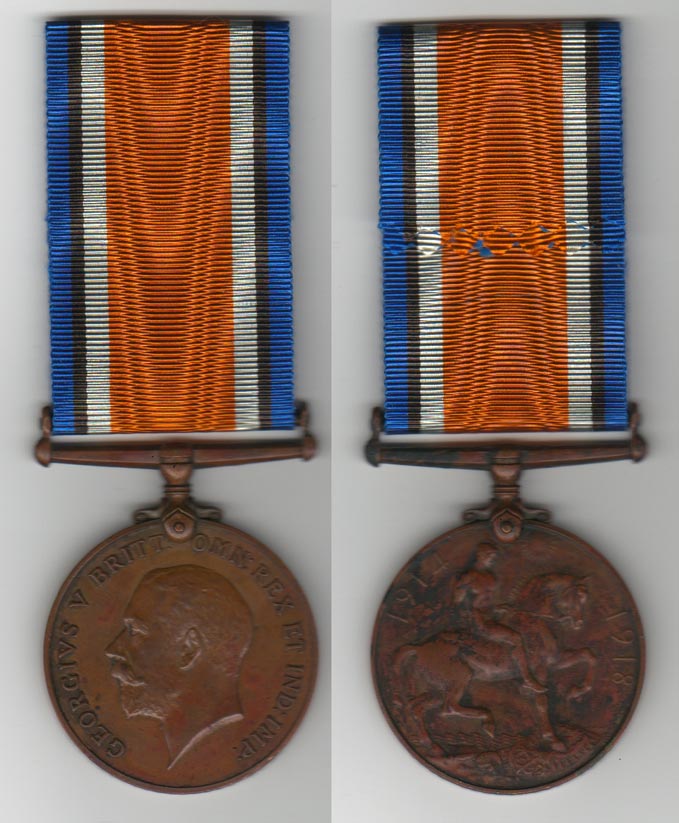 0
0 -
Rob,
Well, I doubt there will be much, if any interest, considering the low number of actual participants in this thread.
I do disagree with adding any Phillipines Constabulary and National Guard items into US States and local issue VIC's though, as these items do not belong together at all. Laslo included them, as a side note, on official VIC's but clearly showed they had nothing really to do with the Interallied Victory Medal. Only appears that everyone wanted a medal for something, regardless of whether or not they actually participated in anything. Same can be said about the Chinese version IMO, as it's not an accepted official VIC.
Then again, the thread Title is: "WW1 Victory Medals of the World" and under that, could/should include all items relating to WW1 VIC's, not just the "Interallied" medals.
Anyway,
Tim
Hey Tim,
I would agree that there does seem to be only a few active participants in this thread. It is surprising given the international flavour of the vic series.
I agree that the Phillipine items are not official vics but have gained some form of association with the interallied vic series, especially from US collectors from what I have seen. Other than Alex Laslo's book and a corresponding OMSA article about the subject there appears little information about them in the wider collecting community. Even the OMSA publication on Phillipine medals has little detail with Laslo's reference containing much more information.
I would also agree that the Chinese commemorative medal is often incorrectly associated with the vic series. If anything there should be more reference to the British War Medal in bronze that was awarded to those chinese members of the Labour Corps (CLC). That is the only 'official' recognition these members of the CLC received as they were deemed not eligible for the vic. They are not that prevalent, are hard to obtain in good condition, and are plagued by many copies and outright fakes. I consider having such an example as illustrative of the Chinese effort and contribution during the war, as they provided many, many personnel for service in the Labour Corps, and it is also probable why China was added to the reverse of the US vic.
In addition to those medals there is also the case of the Panama Medal for Solidarity that was awarded following the war. Alec Purves' book mentions that they were only awarded on a very limited scale and are again immediately identified and associated with the vic series.
Now that you mention it I would agree that it is probably a good idea to just include all the items in this thread, including the US state awards, Phillipine items and any other associated awards including that from Panama. That way all the pieces that people can share, relating to this topic, are in the one spot.
If anything it may create some more discussion. Time will tell.
Regards,
Rob
0 -
Hi Rob,
That's fine.
Well, if there is enough interest and someone wants to start one, I will contribute.
Tim
Tim,
I would also suggest that there should be enough interest in such a newer thread. It could also include those victory type medals that have been seen from the Phillipines Constabulary and National Guard, that seem to be very rare and continually confused with the interallied victory medal series.
Regards,
Rob
0 -
Well, it's been awhile and the thread is starting to get quiet. I figure either people are losing interest or running out of new material to post.
Do we want to venture into the States and local issue VIC's here or should we start a new and separate thread?
Tim

Oregon State issue:
Hey Tim,
I think that while these separate US state vics are interesting they should be in their own separate thread.
Regards,
Rob
0 -
And the close-ups.
That's me done for a while.
Regards,
Rob
 0
0 -
To all,
As mentioned here is the modern repro of the Japanese vic.
Close-ups to follow.
Regards,
Rob
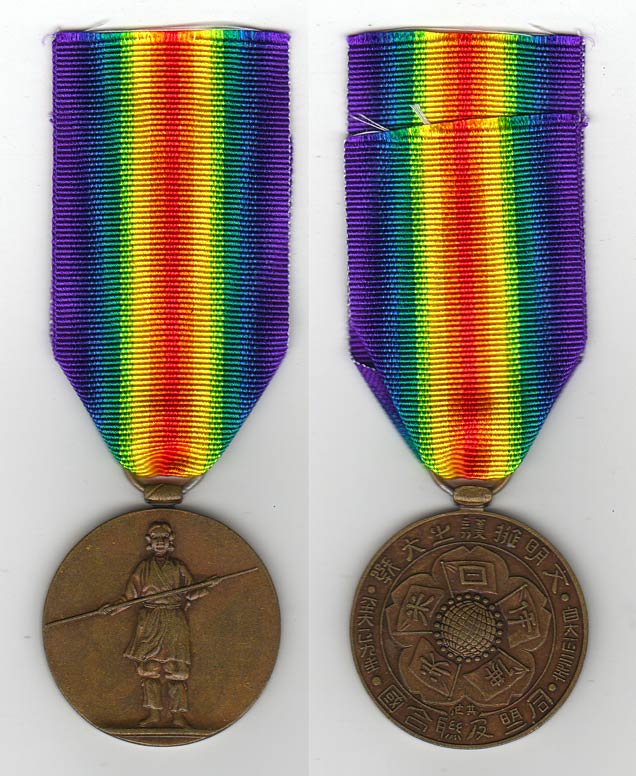 0
0 -
Hi to all,
I believe there is a Japanese Vic repro on ebay which someone filed the ball suspension down to make it look like a barrel shape suspension. It has a cut off repro ribbon, and if you do a zoom in on the reverse you too might notice it. I am sure the dealer has not seen it or he would have mentioned it.
JM
Hello JM,
The Japanese vic repro you are referring to is actually not a repro type 1 as identified in Alex Laslo's book. You are correct in identifying that the repro type 1 is mounted on a ball suspender, and was produced in France in the 1920-1930s period, but the example in this particular auction is not one of those.
The repro in the mentioned auction is a more recent reproduction based on the dies that were also used for the much earlier French repro, hence the similarities. It was produced in the UK, most likely around the Birmingham area [which is where a lot of the more recent repro's are coming from] and was produced with a barrel suspender. These examples are made in a different base metal to the 1920s French variety and have a slightly thicker planchet. In addition they will have, as you have identified, the unblended thicker weave vic ribbon that is also produced in the UK.
When I have time I shall post some comparison pics of this more modern repro.
Regards,
Rob
0 -
I managed to win this "Original Victory Certificate - French" at one of the on line auctions...If any member can make a full translation for me I would greatly appreciate it.
Hello Thomas,
The text in the centre is:
Named individual...
'est autorisé a porter la MÉDAILLE DE LA VICTOIRE (ruban aux coleurs de denx arcs-en-ciel juxtaposes par le rouge avec un filet blanc sur chaque bord)'
My French is not too good but that is roughly translated to:
'Named individual... is authorised to wear the victory medal (ribbon has the colours of the rainbow with a centre red stripe with a white stripe on the edge).
Of note at the bottom of the award certificate is a small footnote:
'Nota. - Par application des dispositions de l'article 13 de la loi du 20 juillet 1922, il n'est pas délivré de diplome et il appartient aux ayants droit de se procurer l'insigne a leurs frais, dans le commerce'
Roughly translated again this indicates...In accordance with item 13 of the law of July 20, 1922 [which established the French vic] the diploma merely gives you the right to wear the award but the individual had to go out and purchase the actual medal at their own expense.
This is not that unusual. Those eligible and awarded the diploma had to obtain the actual medal themselves from any one of the different medal manufacturers that were in the market, and was not limited to just the vic. There are many that believe it is the award certificate that is the important piece because it is individual where the medal is produced by many.
Here is another certificate so others can see the detail.
Hope this helps.
Regards,
Rob
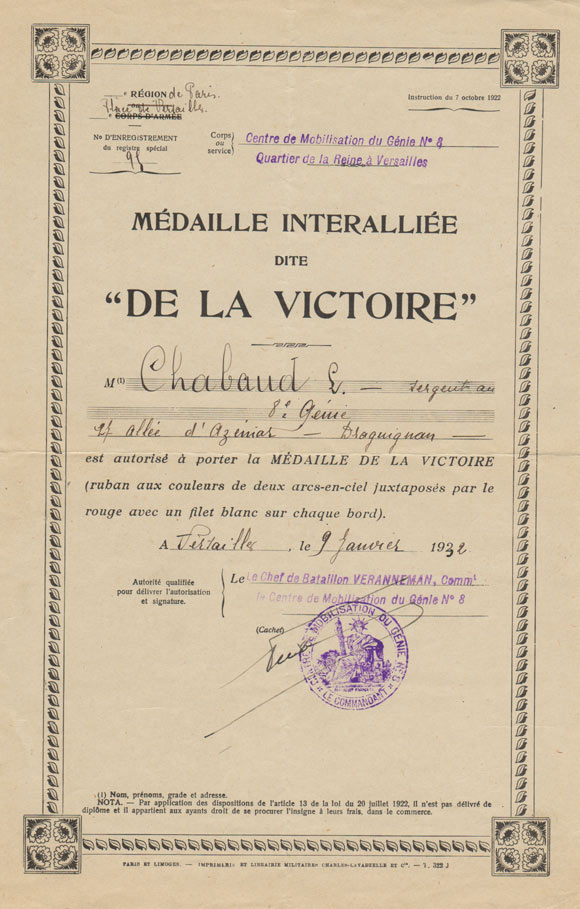 0
0 -
The next two miniatures arrived on Friday too, and they are SMALL ! Rob, your quote, " For your awareness both the Belgian and French vic mini's were produced in a number of sizes including: * Belgian - 12, 13.5 and 17 mm. * French - 11, 13, and 17 mm. " suddenly rang very true. My French mini Vic is very small - 11mm and the Belgium mini Vic is 13.5mm. These "small" miniatures seem really strange to me, as next to any other "normal" miniature they look quite odd. And on a bar I would imagine that they would all but disappear. These miniatures don't have any maker's marks though - unfortunately.
Thomas,
Those collectors that generally confine themselves to the British and other Commonwealth awards, are used to seeing miniatures in a consistent size around 18mm.
It is only when you start collecting such a varied series of medals, like the vics, that were produced by a large number of countries, including many from the European continent, that you become aware of the different sizes of mini's. The Belgians and French produced a wide variety of mini awards in different sizes and it was not just limited to the vic. In addition those mini's produced by Italy and Portugal are also seen in a variety of sizes.
By the same token there are numerous different examples of the British and US vic mini with minor detail changes depending on the manufacturer and time of production so variety abounds.
I think that it is this cosmopolitan nature of the vic series which makes it such an interesting and diverse field of collecting in its own right. Country specific but international in flavour.
Regards,
Rob
0




Romanian Victory Medals
in Inter-Allied Victory Medals of the Great War
Posted
And the reverse.
Regards,
Rob